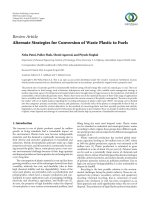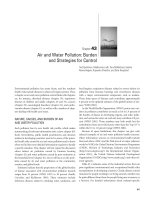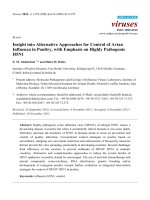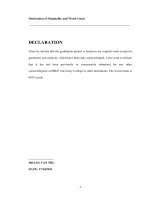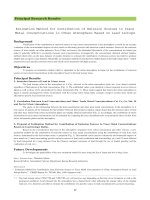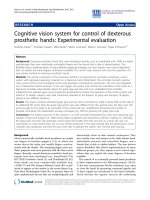Multi strategies for control of motility via mora signaling pathway in pseudomonas putida
Bạn đang xem bản rút gọn của tài liệu. Xem và tải ngay bản đầy đủ của tài liệu tại đây (4.51 MB, 187 trang )
MULTI&STRATEGIES,FOR,CONTROL,OF,
MOTILITY,VIA,MORA,SIGNALING,PATHWAY,
IN,PSEUDOMONAS,PUTIDA,
,
,
,
,
,
NG WEI LING
,
,
,
,
,
NATIONAL UNIVERSITY OF SINGAPORE
2012
!
!
!
MULTI&STRATEGIES,FOR,CONTROL,OF,
MOTILITY,VIA,MORA,SIGNALING,PATHWAY,
IN,PSEUDOMONAS,PUTIDA,
,
,
,
,
,
,
,
,
NG WEI LING
(B. Sc.(Hons), NUS)
A THESIS SUBMITTED FOR THE DEGREE OF
DOCTOR OF PHILOSOPHY
DEPARTMENT OF BIOLOGICAL SCIENCES
NATIONAL UNIVERSITY OF SINGAPORE
2012
!
ACKNOWLEDGEMENTS
I would like to express my heartfelt gratitude to my supervisor A/P Sanjay Swarup
for his valuable guidance and advice in the seven years that I had spent in his lab.
I thank National University of Singapore for providing me with Research
Scholarship and the Mechanobiology Institute for their excellent support and
funding.
It is my pleasure to thank Ms Liew Chye Fong for her excellent support and
unfailing help. My thanks to fellow colleagues and ex-lab mates especially Dr.
Sheela Reuben, Dr. Ayshwarya Ravichandran, Mr Dennis Heng, Ms June Fu,
Ms Wong Chui Ching, Mr. Amit Rai and Ms. Tanujaa Suriyanarayanan for
creating a conducive and joyful working environment in which we had countless
fruitful scientific discussions and words of encouragement.
My thanks to Mr Allan Tan, Mr Chong Ping Lee, Ms Tong Yan and Mdm Loy
Gek Luan for all the advice and technical support given to me. I am deeply
appreciative for the administrative support of the office staff from the Department of
Biological Sciences and special thanks to Ms Reena Devi a/p Samynadan for being
so helpful in graduate administration matters.
I am grateful to my family members and friends for their encouragement. Special
thanks are extended to my mother, Mdm Toh Kim Huay for her support. I could not
find the words to describe my deepest appreciation and gratitude to Mr Keven Ang
for his constant support, love and encouragement, without whom I would never have
been able to complete this thesis.
!
i!
CONTENTS
PAGE
ACKNOWLEDGEMENTS
i
SUMMARY
vii
LIST OF ABBREVIATIONS
x
LIST OF FIGURES
xiii
LIST OF TABLES
xvi
LIST OF PUBLICATIONS/CONFERENCES
xvii
CHAPTER 1
1.
INTRODUCTION
Introduction
CHAPTER 2
1
LITERATURE REVEW
2.
Literature review
7
2.1.
Pseudomonads
7
2.1.1.
Pseudomonas putida
8
2.1.2.
Pseudomonas putida PNL-MK25
10
2.2.
Signaling network in bacteria
11
2.2.1. Cyclic-di-GMP signaling
12
2.2.2. Occurrence of c-di-GMP signaling enzymes
18
2.2.3. Redundancy of c-di-GMP signaling enzymes
20
2.2.4. GGDEF-EAL bidomain proteins
23
2.3.
Bacterial motility
24
2.3.1.Flagellar-mediated motility
2.3.2.Flagellar structure
26
2.3.3.Regulation of flagellar formation
!
24
29
ii!
2.3.4.Chemotaxis
31
2.4.
Biofilm formation in Pseudomonas spp.
34
2.5.
MorA as a membrane bound negative motility regulator
35
2.6.
Reversion mutants of morA phenotype
41
CHAPTER 3
MATERIAL AND METHODS
3.
Materials and methods
46
3.1.
Bacterial strains, plasmids and growth conditions
46
3.2.
Generation of markerless knockout Pseudomonas spp. mutants
50
3.2.1. Electroporation of Pseudomonas culture
51
3.2.2. PCR-amplification of the gentamycin resistance gene cassette
51
3.2.3. PCR-amplification of 5’ and 3’ gene fragments
52
3.2.4. Fusion PCR of 5’ gene fragment, 3’ gene fragment and gentamycin
52
cassette
3.2.5. Cloning of fusion PCR product into pEX18ApGW
53
3.2.6. Selection of markerless knockout clones
55
3.3.
Genomic DNA isolation
56
3.4.
Gene expression studies
56
3.4.1. Complementation and overexpression strains generation
56
3.4.2. RNA isolation and cDNA preparation
57
3.4.3. Quantitative Real-Time PCR
57
3.5.
Site-directed mutagenesis and deletion of EAL domain in MorC
58
3.6.
Swimming motility studies
61
3.6.1. Swimming motility plate assay
61
3.6.2. Single cell swimming speed analysis
61
!
iii!
3.6.3. Cell speed image analysis
61
3.7.
Biofilm formation tube assay
62
3.8.
Chemotaxis assay
62
3.9.
Intracellular localization study
63
3.10.
Transmission electron microscopy (TEM)
63
3.11.
In silico three-dimensional modeling of MorC PDE domain
63
3.12.
Protein expression studies
64
3.12.1. Creating constructs for MorC recombinant protein expression
64
3.12.2. Testing of catalytic protein expression clones for yield and
66
solubility
3.13.
Flagellin quantitation by Western analysis
68
3.13.1. Flagellin preparation
68
3.13.2. Immunoblotting
68
CHAPTER 4
COMPARISONS OF MORA FUNCTION BETWEEN
71
P. PUTIDA AND P. FLUORESCENS
4.1.
Background
72
4.2.
Results and discussion
73
4.2.1. Generation of markerless knockout mutant strains
73
4.2.2. Verification of the markerless knockout ∆morA strain
80
4.2.2.1. Disruption of morA does not affect growth of the ΔMorA cells
80
4.2.2.2. Complementation confirms phenotypic effect of morA
82
4.2.3. Characterization of MorA function in Pf0-1
86
4.2.3.1. ∆morAPf shows no difference in motility when perturbed
4.2.3.2. ∆morAPf do not affect biofilm formation
!
86
89
iv!
4.2.4. SOLiD sequencing of P. putida
4.3.
Conclusion and future work
CHAPTER 5
TWO INDEPENDENT MECHANISMS THAT
91
92
93
AFFECTS HYPERMOTILITY
5.1.
Background
94
5.2.
Results and discussion
96
5.2.1. CyaA acts in an antagonistic manner to MorA to control motility
96
5.2.2. CyaA does not affect biofilm formation
100
5.2.3. OpuAC functions independently of MorA to control motility
102
5.2.4. ∆opuAC strains have reduced biofilm formation
105
5.2.5. ∆opuAC leads to increased production of pyoverdine
107
5.3.
Conclusion and future work
CHAPTER 6
MORC IS A POSITIVE REGULATOR OF
111
114
MOTILITY THAT AFFECTS FLIC GENE EXPRESSION AND
CELL SPEED
6.1.
Background
115
6.2.
Results and discussion
116
6.2.1. MorC is highly conserved in Pseudomonas species
116
6.2.2. MorC is a positive regulator of motility that functions downstream
119
from MorA
6.2.3. Mutation in morC do not affect biofilm formation in P. putida
6.2.4. Mutation in morC do not affect chemotaxis
124
6.2.5. Sequence analysis of MorC suggests that it is a functional PDE
!
122
126
v!
6.2.6. MorC function is dependent on its PDE domain
128
6.2.7. morC is expressed in a growth-stage dependent manner
131
6.2.8. MorC is expressed in a growth-stage dependent manner
134
6.2.9. ∆morC is a new regulator of fliC expression
136
6.2.10. MorC do not affect motility via flagellar number
138
6.2.11. MorC controls motility via cell speed
141
6.3.
Conclusion and future work
BIBLIOGRAPHY
144
148
APPENDICES
I. Sequence similarity of MorA to tdEAL, used for in silico modeling of
domain structure
158
II. SoLiD sequencing data analysis summary
159
III. MorC gene and protein sequences
163
IV. Phylogram tree of MorC homologs
166
V. Taxonomy report of MorC conservation
167
!
vi!
SUMMARY
Motility is a highly regulated process required in many aspects of growth, survival
and pathogenesis. In the case of swimming motility, flagellar biogenesis usually
begins during the log phase to stationary phase transition where there is a reduction in
nutritional levels and cessation of cell division. Previously, our lab described MorA, a
well-conserved membrane-localized negative regulator of motility that controls the
timing of flagellar development. It was found to affect motility, chemotaxis and
biofilm formation in Pseudomonas putida PNL-MK25. As morA loss leads to
hypermotility, random mutagenesis was carried out on the morA mutant strain to
identify members of its signaling pathway by screening for transposon double mutants
that exhibited reversion in motility. Of the genes identified, cyaA, morC and the
substrate-binding region of ABC type transporter system for glycine betaine (opuAC)
were selected for further study.
cyaA expression in the absence of morA leads to increased motility while cyaA
expression in the presence of morA leads to reduction in motility. Hence, MorA exerts
a dominant effect over CyaA. Also, cyaA acts in an antagonistic manner with morA to
control motility while biofilm formation is unaffected. In contrast, the disruption of
opuAC in ∆morA was not able to revert the hypermotility phenotype. ∆opuAC
exhibited a 3-fold increase in motility and a reduction in biofilm formation as
compared to the wild type, suggesting that it acts as a negative regulator of motility
independently of MorA. Interestingly, ∆opuAC was found to increase pyoverdine
production in M9 medium by 45%.
!
vii!
Homology analysis indicates that ASNEF and EAL motif is conserved in MorC.
Phenotypic characterization of ∆morC and ∆morA∆morC reveals that MorC is a
positive regulator of motility that functions downstream of MorA in a non-dosage
dependent manner while not affecting biofilm formation or chemotaxis. GFP-tagged
MorC was found to be expressed throughout the cell in the early- and late-log phase
but not in the mid-log phase. Hence, MorC function is regulated in a growth-phase
dependent manner without being sequestered to a specific cellular location.
A truncated MorC construct, in which the PDE domain was removed, was not able to
complement for the loss of morC. This suggests that the PDE domain is critical for its
function. Site-directed mutagenesis of the E and L residues of the EAL motifs in PDE
domain located at the active site led to loss of complementation while mutations away
from the active site resulted in hyperactivity that increased motility. This
hyperactivity was lost in the absence of MorA, suggesting that long-range
conformational changes may be involved in the regulation of MorC. While MorC
PDE domain is critical for its function, it may not be dependent on its enzymatic
activity.
While MorC is a positive regulator of fliC expression, flagellated cell numbers
suggest that MorC does not control motililty by increasing flagellar number or
affecting flagellar structure. Rather, MorC controls cell speed in the early and late-log
phase in an EAL motif-specific manner. This is the first report to suggest specific
function to the E and L residues in the EAL motif.
!
viii!
Here, we showed that the cyaA and morC controls motility without perturbation of
biofilm formation while opuAC controls motility and biofilm. A different strategy was
demonstrated by each of the gene studied: CyaA acts in an antagonistic manner with
MorA; OpuAC functions independently of MorA while MorC functions downstream
of MorA.
!
ix!
LIST OF ABBREVIATIONS
Bacterial strains
E. coli
G. xylinus
H. pylori
P. aeruginosa
P. fluorescens
P. putida
S. typhimurium
Escherichia coli
Gluconacetobacter xylinus
Helicobacter pylori
Pseudomonas aeruginosa
Pseudomonas fluorescens
Pseudomonas putida
Salmonella typhimurium
Units and Measurements
Abs
bp
cm
Ct
ºC
fps
g
h
kb
kDa
kV
L
M
mg
min
ml
mM
ng
nm
nt
O.D.
rpm
s
mbp
mg
mL
mM
mm
UV
V
w/v
!
absorbance
base pair
centimetre
threshold cycle
degree Celcius
frames per second
centrifugal force
hour
kilo base pair
kilodalton
kilovolt
litre
moles per litre
milligram
minute
millilitre
millimole
nanogram
nanometre
nucleotide
optical density
revolutions per minute
second
Million base pair
microgram
microlitre
micromoles
micrometre
ultraviolet
volts
weight per volume
x!
v/v
%
volume per volume
percent
Chemicals and reagents
Amp
BSA
cAMP
c-di-GMP
ampicillin
bovine serum albumin
3’5’-cyclic adenosine monophosphate
cyclic diguanylate, cyclic-bis(3'-->5') dimeric guanosine
monophosphate
cGMP
Cb
Cm
EDTA
Gm
GMP
GTP
HCl
IPTG
Km
LB
M9
NaCl
NaOH
PBS
pGpG
ppGpp
Rf
RNA
SDS-PAGE
Tet
3’5’- cyclic guanosine monophosphate
carbenicillin
chloramphenicol
ethylene-diamine-tetra-acetate
gentamycin
guanosine monophosphate
guanosine triphosphate
hydrochloric acid
isopropyl β-D-1-thiogalactopyranoside
kanamycin
Luria-Bertani
M9 salts minimum medium
sodium chloride
sodium hydroxide
phosphate-buffered saline
5’ linear diguanylic acid
Guanosine tetraphosphate
rifampicin
ribonucleic acid
sodium dodecyl sulphate polyacrylamide gel electrophoresis
tetracycline
Enzymes
DGC
PDE
diguanylate
cyclase
phosphodiesterase
Others
ABC
α
β
!
ATP-binding cassette
alpha
beta
xi!
CCW
cDNA
Ct
CW
EAL
EPS
et al.
GFP
GGDEF
HD-GYP
HPLC
H20
I-site
PAC
PAGE
PAS
PCR
PGPR
RT-PCR
spp.
TEM
TLC
M
T
WT
!
counterclockwise
complementary deoxyribonucleic
acid
cycle threshold
clockwise
canonical “Glu-Ala-Leu” motif
with phosphodiesterase activity
extracellular polymeric substances
et alia
green fluorescent protein
canonical “Gly-Gly-Asp-Glu-Phe”
motif of a domain with diguanylate
cyclase activity
“His-Asp-Gly-Tyr-Pro” motif of a
domain with phosphodiesterase
activity
high performance liquid
chromatography
water
Inhibitory site
PAS-associated C-terminal domain
polyacrylamide gel electrophoresis
Per-Arnt-Sim domain
polymerase chain reaction
plant growth-promoting
rhizobacterial
reverse transcriptase polymerase
chain reaction
species
transmission electron microscopy
thin layer chromatography
mid-log phase
log-to-stationary transition phase
wild type
xii!
LIST OF FIGURES
PAGES
Figure 2-1
Schematic of c-di-GMP synthesis and degradation
14
Figure 2-2
Components of a c-di-GMP signaling module
17
Figure 2-3
Occurrence of GGDEF and EAL domains across 867
19
bacterial genomes
Figure 2-4
The bacterial flagellum
28
Figure 2-5
Two-state model of receptor signaling and the
33
chemotaxis phosphorelay pathway
Figure 2-6
Domain architecture of MorA family members in
36
Pseudomonas species
Figure 2-7
Flagella phenotype of morA knockout and WT strains in
39
P. putida and P. aeruginosa
Figure 2-8
Biofilm formation of morA knockout and WT strains in
40
P. putida and P. aeruginosa
Figure 2-9
Motility reversion mutants exhibit reduced motility
43
when compared to morA mutant
Figure 2-10
Motility reversion mutants exhibit varying amount of
44
biofilm formation
Figure 2-11
Growth curves of P. putida WT and various mutants in
45
LB medium showed no differences in the growth
Figure 3-1
Workflow used for the generation of markerless
50
knockout strains
Figure 3-2
Map of pEX18ApGW suicide vector
53
Figure 3-3
Recombinant MorC is mainly present in the insoluble
67
fraction of cellular proteins
!
xiii!
Figure 3-4
Preliminary trials of Western blot analysis of flagellin
70
levels
Figure 4-1
Schematic illustration of mutant fragment generation by
74
overlap extension PCR
Figure 4-2
Confirmation of markerless knockout mutant genotypes
77
by PCR
Figure 4-3
morA markerless knockout strain DNA sequence
79
analysis
Figure 4-4
Growth curve of various P. putida strains
81
Figure 4-5
Complementation of morA was able to store swimming
83
motility phenotype
Figure 4-6
morA affects biofilm formation in P. putida PNL-MK25
85
Figure 4-7
∆morAPf do not affect swimming motility phenotype on
88
plate motility assay
Figure 4-8
∆morAPf do not affect biofilm formation
90
Figure 5-1
CyaA acts in an antagonistic manner to MorA to control
98
motility
Figure 5-2
CyaA does not affect biofilm formation in P. putida
101
Figure 5-3
opuAC acts independently of morA in P. putida
104
Figure 5-4
∆opuAC strain has reduced biofilm formation
106
Figure 5-5
∆opuAC and WT shows differences in the stationary
108
phase of growth curve
Figure 5-6
Pyoverdine production is increased by 45% in ∆opuAC
110
Figure 5-7
Different strategies employed by CyaA and OpuAC to
113
!
xiv!
control motility
Figure 6-1
Conservation of morC gene in Pseudomonas species
118
Figure 6-2
∆morC mutant exhibits reduced swimming motility
121
Figure 6-3
MorC does not affect biofilm formation
123
Figure 6-4
Chemotactic response of various morC mutants towards
125
100mM aspartate
Figure 6-5
The sequence of MorC suggests that it may encode for
127
an inactive DGC domain with a functional PDE domain
Figure 6-6
MorC function is dependent on its PDE domain
130
Figure 6-7
morC expression is growth stage dependent
133
Figure 6-8
MorC-GFP is observed throughout the cells in growth-
135
stage dependent manner
Figure 6-9
MorC is a new regulator of fliC expression
137
Figure 6-10
MorC does not enhance swimming motility via
140
flagellation related processes
Figure 6-11
Cell speed analysis shows that MorC affects the cell
143
speed in a growth-stage dependent manner
Figure 6-12
Different strategies deployed to control motility via
147
MorA signaling pathway
!
!
xv!
LIST OF TABLES
Table 2-1
Spatial localization signals and partner domain
PAGES
22
occurrence for GGDEF and EAL proteins
Table 2-2
Transposon motility reversion mutants in morA
42
knockout background identified via single primer PCR
Table 3-1
Bacterial strains used in this study
47
Table 3-2
Plasmids used in this study
48
Table 3-3
Primers used in markerless knockout generation
54
Table 3-4
Primers used in qRT-PCR.
59
Tabl3 3-5
Primers used for various site-directed and deletion
constructs of morC
60
Table 3-6
Primer list for creating recombinant MorC protein
expression construct
65
Table 4-1
SOLiD sequencing preliminary data
91
Table 5-1
Effects of combinations of morA and cyaA genes on
motility
99
!
xvi!
LIST OF PUBLICATIONS/CONFERENCES
PUBLICATIONS
Wong CC, Ng WL, Huang WD, Sun Q, Sivaraman J, Swarup S. Recruitment of
phosphodiesterase catalytic residues for the regulation of diguanylate cyclase activity
affects biological functions (In review)
Ng, WL, Fu SJ, Swarup S. MorC is a positive regulator of motility that functions
downstream of MorA in a growth-phase dependent manner (in preparation)
CONFERENCES
Ng WL, Swarup S. Cyclic-di-GMP signaling pathway in motility and biofilm
formation networks in Pseudomonas putida. 14th Biological Sciences Graduate
Congress, Bangkok. Chulalongkorn University: Bangkok, Thailand, 2009.Poster.
Ng, WL, Swarup S. Cyclic-di-GMP signaling pathway in motility and biofilm
formation networks in Pseudomonas putida. 6th International Conference on
Structural Biology and Functional Genomic, Singapore. National University of
Singapore: Singapore, 2010. Poster 115.
Ng WL, Swarup S. Cyclic-di-GMP signaling pathway in motility and biofilm
formation networks in Pseudomonas putida. 15th Biological Sciences Graduate
Congress, Kuala Lumpur. University of Malaya: Kuala Lumpur, Malaysia,
2010.Poster.
Wong CC, Ng WL, Huang WD, Swarup S. Motility of Pseudomonas spp. is
controlled by the signalling messenger cyclic diguanylate. 6th International
Conference on Structural Biology and Functional Genomic, Singapore. National
University of Singapore: Singapore, 2010. Poster 113.
Wong CC, Ng WL, Huang WD, Swarup S. Motility of Pseudomonas spp. is
controlled by the signalling messenger cyclic diguanylate. 15th Biological Sciences
Graduate Congress, Kuala Lumpur. University of Malaya: Kuala Lumpur, Malaysia,
2010.Oral presenter (No: CMB-14), awarded second prize.
!
xvii!
Chapter 1. Introduction
1. INTRODUCTION
Bacterial cells can exist either as free-swimming planktonic s or in surface-attached
communities known as biofilms. Both movement and ability to form biofilm are key
processes for the survival of bacteria in diverse environments. The classical growth
and developmental changes in planktonic cells are represented by the lag phase,
logarithmic (log) phase, log-to-stationary transition phase and the stationary phase.
The log-to-stationary transition phase is marked by the cessation of cell division as
nutrients get depleted and with the onset of flagellar development (Amsler et al.,
1993; Givskov et al., 1995). The complex biogenesis of the flagellar apparatus
requires a well-coordinated regulation of the flagellar pathway. When bacteria come
in contact with surfaces, their attachment followed by biofilm formation takes place.
During this phase, flagella are shed and bacteria become sessile. Therefore,
emergence of flagella is generally considered as a developmental hallmark in many
types of bacteria.
While flagellar appearance marks a developmental change in free-living planktonic
cells, formation of biofilms leads to yet another developmental pathway in surfaceattached bacterial communities. Biofilms are essential elements in virulence,
colonization, and survival. Planktonic cells undergo multiple developmental changes
during their transition from free-swimming organisms to cells that makeup
the biofilms (Stoodley et al., 2002). Flagella-mediated motility is required in many
instances, such as initial cell-to-substrate interactions and/or subsequent biofilm
development (O’Toole and Kolter, 1998). Appropriate levels of flagellin subunits
1
seem to be a key factor since over expression of flagellin in E. coli results in reduced
adhesion to hydrophilic substrates (Landini and Zehnder, 2002). In fully developed
biofilms, bacteria such as P. putida may even lack flagella (Sauer and Camper, 2001).
To interact with the environment and then react rapidly, bacterial signaling network is
highly complex. Signaling systems utilized by bacteria includes cell-cell signaling
such as quorum sensing, two-component phosphorelays and second messenger
signaling. Genomic and signaling studies on new models led to the finding that
signaling proteins are typically modular in nature with each conserved domain
performing a distinct biochemical function. Thus it became possible to predict protein
function through bioinformatics studies that in recent years, with the availability of
complete bacterial genome sequences, has helped reveal a new class of proteins
containing GGDEF and EAL domains, although they are absent in archea and
eukaryotes (Jenal, 2004; Mills et al., 2011). Gram-negative bacteria tend to have
more of such proteins than Gram-positive bacteria (Galperin et al., 2001; Pei
and Grishin, 2001). These domains are known to play a part in regulation of several
processes
such
as
cell
development, virulence,
motility
and
cellulose biosynthesis (Aldridge et al., 2003; Ausmees et al., 1999; Huang et al.,
2003; Merkel et al., 1998). Proteins containing GGDEF and EAL motifs have been
described in many prokaryotic proteins, often in combination with other putative
sensory-regulatory domains such as the PAS and PAC domains whose proposed
functions are as sensors for light, redox potential or oxygen concentration (Tamayo et
al., 2007; Yan and Chen, 2010). Adaptations involving changes in exopolysaccharides
and proteinaceous appendages are regulated in diverse bacteria via proteins with
GGDEF and EAL domains. These proteins are predicted to regulate cell adhesion
2
to surfaces by controlling the level of a secondary messenger, c-di-GMP (D'Argenio
and Miller, 2004; Jenal, 2004). The abundance of genes encoding GGDEF and EAL
containing proteins argues for the existence of a dedicated regulatory network that
converts a variety of different signals into c-di-GMP to function as a secondary
messenger in signal transduction (Christen et al., 2006).
Interestingly, bidomain proteins with both GGDEF and EAL domains constitute
nearly a third of proteins with GGDEF and EAL domains. Most bidomain proteins are
found to have a single functional domain. As such, it has been proposed that the
noncatalytic domain functions in a regulatory capacity (Wolfe and Visick, 2008). In
cases where both domains are active, one or the other enzymatic activities is activated
by sensory cues or interaction with other proteins.
For instance, MorA affects
flagellar motor function by reducing rotation speeds and increasing pauses through its
diguanylate cyclase (DGC) activity. While DGC is the dominant activity, it also
exhibits weak phosphodiesterase (PDE) activity. The PDE domain affects DGC
activity via two novel inter-domain interactions. The PDE domain constitutively
imparts a 6-fold increase in DGC activity through the glutamate residue of its EAL
motif as well as reduces DGC activity through product inhibition in a dose-dependent
manner via the leucine of its EAL motif (Wong, 2011).
MorA is a negative motility regulator identified in our laboratory. It affects the
number and timing of flagella expression and biofilm formation in Pseudomonas
species. MorA is conserved among diverse proteobacteria groups and cyanobacteria.
All Pseudomonas genomes sequenced thus far possess morA homologs including P.
3
aeruginosa PAO1 (PA4601), P. fluorescens Pf0-1 (Pfl01_4876) and P. putida
KT2440 (PP0672).
Video microscopy showed that the morA mutant cells were highly motile throughout
different growth phases. Most of the wild type (WT) cells were, however, non-motile
in all the three growth phases. Hence, morA mutants had a developmental restriction
removed on the timing of flagellar formation, resulting in the presence of flagella
throughout the growth stages without affecting cell division or cell size.
The loss of morA has been shown to affect the fliC expression in P. putida. This
suggests that the disruption of morA resulted in derepression of flagellin and
expression and, consequently, flagella were constitutively produced. MorA is,
therefore, a key component of an alternative regulatory system that normally restricts
the timing of expression of the flagellar biosynthesis pathway to late phases of growth
in P. putida by derepressing flagellin expression in the log-to-stationary phase. A
consequence of this appears to be the impairment of biofilm formation. However,
when tested for function in Pseudomonas species, its role in flagellar development
and biofilm formation appears to vary between species. In P. putida, expression
analyses revealed that transcript levels of the flagellar master regulators fleQ and fliA
remained unchanged between WT and morA mutant strains (Choy, 2005).
The
mechanism by which morA regulates flagellin expression in the P. putida remains,
hitherto, unknown.
As morA loss leads to hypermotility, we screened for hypermotility reversion to wild
type levels in a library of mutants with morA mutation genetic background in order to
identify downstream signaling pathway members in the motility pathway in P. putida.
4
A total of 3500 transposon insertion mutants were generated and screened via plate
motility assay followed by video microscopy. It was reasoned that any disruption in
the flagellar pathway would cause serious defects in swimming motility via the
malformation or malfunction of the flagella, resulting in non-motile cells. 76 motility
reversion mutants had reversion of the hypermotility phenotype of morA mutants to
those of wild type while not resulting in non-motility. Thus far, a total of 22 genes
have been identified via single primer PCR, of which five genes are of particular
interest (Ng, 2006).
Previously, the MorA signaling pathway members were tentatively identified and
characterized. In this Thesis, we created targeted knockout mutants in various
combinations to investigate the interactions of MorA with MorC, CyaA and the
substrate-binding region of ABC-type glycine betaine transport system (OpuAC). I
studied their roles in regulating motility, biofilm formation and other related
phenotypes. Hence, I set the following objectives for my study:
1. To ascertain the phenotypes observed previously with morA mutant and to
explore morA function in P. fluorescens (Pf0-1) (Chapter 4).
I created markerless knockout strains of morA in P. putida PNL-MK 25 and
Pf0-1 to study if the phenotype observed is conserved across species.
Markerless knockout strains of various genes of interest namely: morC, cyaA
and opuAC were also created for further studies.
2. To understand the role of CyaA and OpuAC in MorA signaling pathway
controlling motility (Chapter 5).
5
